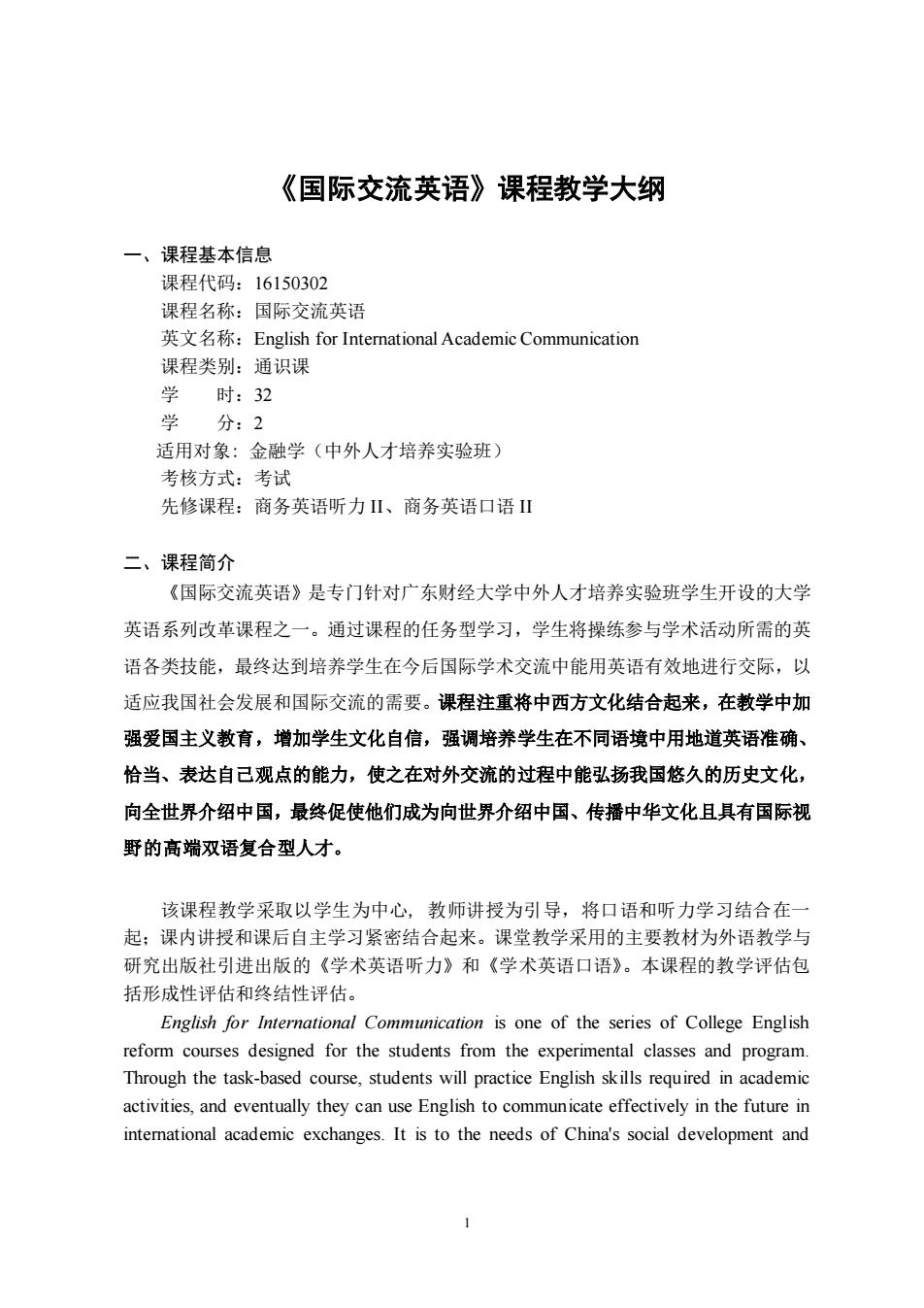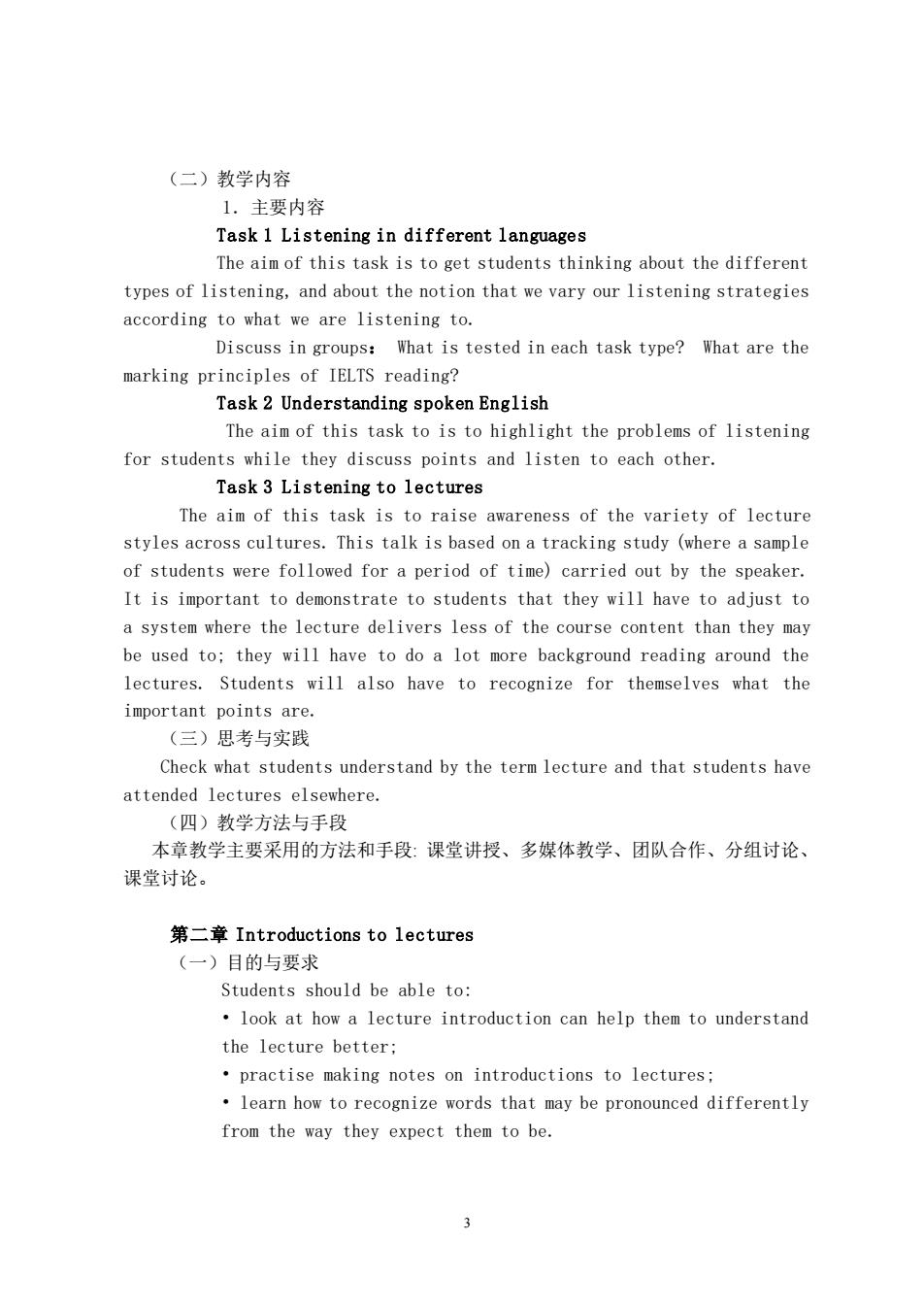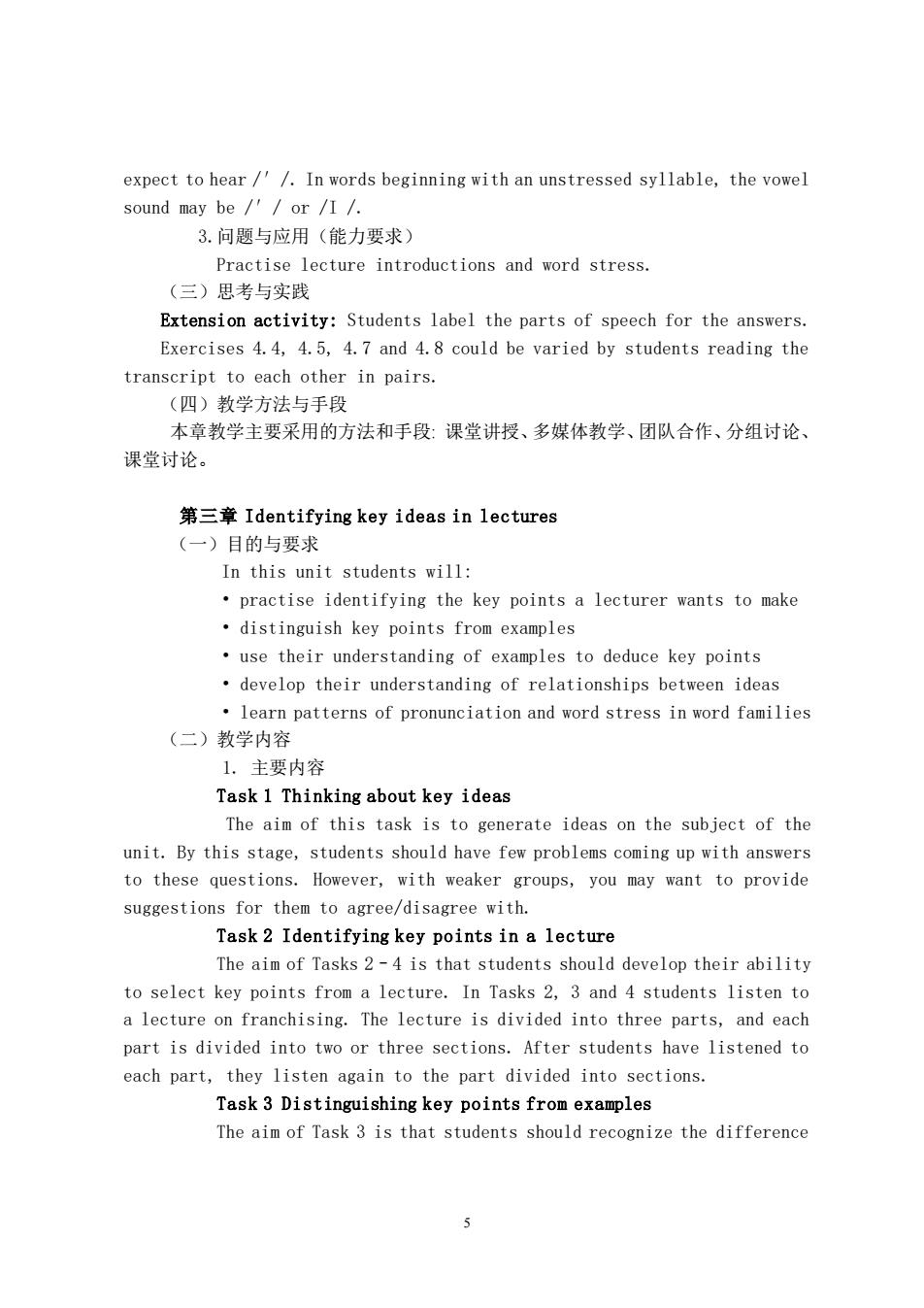
《国际交流英语》课程教学大纲 一、课程基本信息 课程代码:16150302 课程名称:困际交流英语 英文名称:English for International Academic Communication 课程类别:通识课 时:32 学 分:2 适用对象:金融学(中外人才培养实验班) 考核方式:考试 先修课程:商务英语听力Ⅱ、商务英语口语Ⅱ 二、课程简介 《国际交流英语》是专门针对广东财经大学中外人才培养实验班学生开设的大学 英语系列改革课程之一。通过课程的任务型学习,学生将操练参与学术活动所需的英 语各类技能,最终达到培养学生在今后国际学术交流中能用英语有效地进行交际,以 适应我国社会发展和国际交流的需要。课程注重将中西方文化结合起来,在教学中加 强爱国主义教育,增加学生文化自信,强调培养学生在不同语境中用地道英语准确、 恰当、表达自己观点的能力,使之在对外交流的过程中能弘扬我国悠久的历史文化, 向全世界介绍中国,最终促使他们成为向世界介绍中国、传播中华文化且具有国际视 野的高端双语复合型人才。 该课程教学采取以学生为中心,教师讲授为引导,将口语和听力学习结合在一 起:课内讲授和课后自主学习紧密结合起来。课堂教学采用的主要教材为外语教学与 研究出版社引进出版的《学术英语听力》和《学术英语口语》。本课程的教学评估包 括形成性评估和终结性评估。 English for International Communication is one of the series of College English reform courses designed for the students from the experimental classes and program Through the task-based course,students will practice English skills required in academic activities,and eventually they can use English to communicate effectively in the future in international academic exchanges.It is to the needs of China's social development and 1
1 《国际交流英语》课程教学大纲 一、课程基本信息 课程代码:16150302 课程名称:国际交流英语 英文名称:English for International Academic Communication 课程类别:通识课 学 时:32 学 分:2 适用对象: 金融学(中外人才培养实验班) 考核方式:考试 先修课程:商务英语听力 II、商务英语口语 II 二、课程简介 《国际交流英语》是专门针对广东财经大学中外人才培养实验班学生开设的大学 英语系列改革课程之一。通过课程的任务型学习,学生将操练参与学术活动所需的英 语各类技能,最终达到培养学生在今后国际学术交流中能用英语有效地进行交际,以 适应我国社会发展和国际交流的需要。课程注重将中西方文化结合起来,在教学中加 强爱国主义教育,增加学生文化自信,强调培养学生在不同语境中用地道英语准确、 恰当、表达自己观点的能力,使之在对外交流的过程中能弘扬我国悠久的历史文化, 向全世界介绍中国,最终促使他们成为向世界介绍中国、传播中华文化且具有国际视 野的高端双语复合型人才。 该课程教学采取以学生为中心, 教师讲授为引导,将口语和听力学习结合在一 起;课内讲授和课后自主学习紧密结合起来。课堂教学采用的主要教材为外语教学与 研究出版社引进出版的《学术英语听力》和《学术英语口语》。本课程的教学评估包 括形成性评估和终结性评估。 English for International Communication is one of the series of College English reform courses designed for the students from the experimental classes and program. Through the task-based course, students will practice English skills required in academic activities, and eventually they can use English to communicate effectively in the future in international academic exchanges. It is to the needs of China's social development and

interational exchanges. The course puts students as the center,and combines oral and listening training Students'self-study is strictly required.The main course books used are Academic English Listening and Academic English Speaking published by FLTRP.The evaluation of this course includes formative assessment and summative assessment. 三、课程性质与教学目的 《国际交流英语》是一门通识必修课,其主要目的是为我校必须参加雅思考试的 中外人才培养实验班同学提供系统学习学术英语语言、培养学术交流能力的机会,同 时通过大量听说训练提高学生的学术英语素养、学术英语听说和跨文化交际能力,提 升他们的批判性思维能力和跨文化交际意识。 学生学完该门课程后,应能达到以下要求: 1) 掌握大多数英文学术讲座的结构,听讲同时可以做好笔记 2) 掌握英语口语中的多种微观技巧,如弱读、连读等: 3) 学生的语篇分析和概括能力显著提升,语言表达丰富多样化:帮助学生 掌握当下社会热点的英文词汇与表达方式,通过进行爱国主题讨论与演讲,培养、增 强学生的民族自信心与爱国、报国之心。 培养批判性思维,提升学生在跨文化交际中的辩证性思考能力,能够辩 驳是非,据理力争,使之在对外交流的过程中能更有效地介绍中国的历史、文化与发 展,进一步帮助学生树立正确价值观和加强爱国主义教育。 5) 学生基本了解和掌握学术英语语言特色,为学术交流和跨文化交际等打好 基础。 四、教学内容及要求 Part I Listening 第一章Listening and lectures (一)目的与要求 Students should be able to: discuss the different situations in which they have to listen identify what factors influence their ability to understand learn about features of lectures in different academic cultures 2
2 international exchanges. The course puts students as the center, and combines oral and listening training. Students’ self-study is strictly required. The main course books used are Academic English Listening and Academic English Speaking published by FLTRP. The evaluation of this course includes formative assessment and summative assessment. 三、课程性质与教学目的 《国际交流英语》是一门通识必修课,其主要目的是为我校必须参加雅思考试的 中外人才培养实验班同学提供系统学习学术英语语言、培养学术交流能力的机会,同 时通过大量听说训练提高学生的学术英语素养、学术英语听说和跨文化交际能力,提 升他们的批判性思维能力和跨文化交际意识。 学生学完该门课程后,应能达到以下要求: 1) 掌握大多数英文学术讲座的结构,听讲同时可以做好笔记; 2) 掌握英语口语中的多种微观技巧,如弱读、连读等; 3) 学生的语篇分析和概括能力显著提升,语言表达丰富多样化;帮助学生 掌握当下社会热点的英文词汇与表达方式,通过进行爱国主题讨论与演讲,培养、增 强学生的民族自信心与爱国、报国之心。 4) 培养批判性思维,提升学生在跨文化交际中的辩证性思考能力,能够辩 驳是非,据理力争,使之在对外交流的过程中能更有效地介绍中国的历史、文化与发 展,进一步帮助学生树立正确价值观和加强爱国主义教育。 5) 学生基本了解和掌握学术英语语言特色,为学术交流和跨文化交际等打好 基础。 四、教学内容及要求 Part I Listening 第一章 Listening and lectures (一)目的与要求 Students should be able to: • discuss the different situations in which they have to listen • identify what factors influence their ability to understand • learn about features of lectures in different academic cultures

(二)教学内容 1.主要内容 Task 1 Listening in different languages The aim of this task is to get students thinking about the different types of listening,and about the notion that we vary our listening strategies according to what we are listening to. Discuss in groups:What is tested in each task type?What are the marking principles of IELTS reading? Task 2 Understanding spoken English The aim of this task to is to highlight the problems of listening for students while they discuss points and listen to each other. Task 3 Listening to lectures The aim of this task is to raise awareness of the variety of lecture styles across cultures.This talk is based on a tracking study (where a sample of students were followed for a period of time)carried out by the speaker. It is important to demonstrate to students that they will have to adjust to a system where the lecture delivers less of the course content than they may be used to:they will have to do a lot more background reading around the lectures.Students will also have to recognize for themselves what the important points are. (三)思考与实践 Check what students understand by the term lecture and that students have attended lectures elsewhere. (四)教学方法与手段 本章教学主要采用的方法和手段:课堂讲授、多媒体教学、团队合作、分组讨论、 课堂讨论。 第二章Introductions to lectures (一)目的与要求 Students should be able to: look at how a lecture introduction can help them to understand the lecture better; practise making notes on introductions to lectures: .learn how to recognize words that may be pronounced differently from the way they expect them to be. 3
3 (二)教学内容 1.主要内容 Task 1 Listening in different languages The aim of this task is to get students thinking about the different types of listening, and about the notion that we vary our listening strategies according to what we are listening to. Discuss in groups: What is tested in each task type? What are the marking principles of IELTS reading? Task 2 Understanding spoken English The aim of this task to is to highlight the problems of listening for students while they discuss points and listen to each other. Task 3 Listening to lectures The aim of this task is to raise awareness of the variety of lecture styles across cultures. This talk is based on a tracking study (where a sample of students were followed for a period of time) carried out by the speaker. It is important to demonstrate to students that they will have to adjust to a system where the lecture delivers less of the course content than they may be used to; they will have to do a lot more background reading around the lectures. Students will also have to recognize for themselves what the important points are. (三)思考与实践 Check what students understand by the term lecture and that students have attended lectures elsewhere. (四)教学方法与手段 本章教学主要采用的方法和手段: 课堂讲授、多媒体教学、团队合作、分组讨论、 课堂讨论。 第二章 Introductions to lectures (一)目的与要求 Students should be able to: • look at how a lecture introduction can help them to understand the lecture better; • practise making notes on introductions to lectures; • learn how to recognize words that may be pronounced differently from the way they expect them to be

(二)教学内容 1.主要内容 Task 1 Thinking about introductions The aim of this task is simply to give you an idea of the students level of awareness of the content and organization of academic lectures. 1.1 If students have already attended lectures,you may like to begin by asking them to recall what the lecturer(s)did in lecture introductions. You may also like to get students to think about introductions in essays and presentations,and to discuss what these have in common and what may be different.Elicit their own ideas and summarize them on the board for later comparison with the list in Task 2. 1.2 Students should be aware that: some lecturers use visuals,PowerPoint slides or handouts to give an overview of their lecture some speakers structure lectures verbally by giving an overview in the introduction,and/or by using 'transition language'to move from one section to another 1.3 With lower-level groups,you may need to guide students to the answers through yes/no concept-check questions such as:Did Student 1 think the lecture was about migration to the UK?Was the migration from the USA?, etc. Task 2 Functions and language of lecture introductions The aim of this task is to highlight the functions of lecture introductions and the language used to express them. Note:To save time,you could set these activities for homework Task 3 Listening to lecture introductions The aim of this task is to put Task 2 into context using lecture examples Task 4 Microskills:Word stress This task focuses on word stress and the effect it has on the pronunciation of unstressed syllables in words.Students may have difficulty understanding words beginning with an unstressed syllable,because they expect to hear a different vowel sound.For example,in the first syllables of consume and assist they may expect to hear two different vowel sounds,and may not 4
4 (二)教学内容 1.主要内容 Task 1 Thinking about introductions The aim of this task is simply to give you an idea of the students’ level of awareness of the content and organization of academic lectures. 1.1 If students have already attended lectures, you may like to begin by asking them to recall what the lecturer(s) did in lecture introductions. You may also like to get students to think about introductions in essays and presentations, and to discuss what these have in common and what may be different. Elicit their own ideas and summarize them on the board for later comparison with the list in Task 2. 1.2 Students should be aware that: ⚫some lecturers use visuals, PowerPoint slides or handouts to give an overview of their lecture ⚫some speakers structure lectures verbally by giving an overview in the introduction, and/or by using ‘transition language’ to move from one section to another 1.3 With lower-level groups, you may need to guide students to the answers through yes/no concept-check questions such as: Did Student 1 think the lecture was about migration to the UK? Was the migration from the USA?, etc. Task 2 Functions and language of lecture introductions The aim of this task is to highlight the functions of lecture introductions and the language used to express them. Note: To save time, you could set these activities for homework Task 3 Listening to lecture introductions The aim of this task is to put Task 2 into context using lecture examples. Task 4 Microskills: Word stress This task focuses on word stress and the effect it has on the pronunciation of unstressed syllables in words. Students may have difficulty understanding words beginning with an unstressed syllable, because they expect to hear a different vowel sound. For example, in the first syllables of consume and assist they may expect to hear two different vowel sounds, and may not

expect to hear /'/In words beginning with an unstressed syllable,the vowel sound may be /'or /I/. 3.问题与应用(能力要求) Practise lecture introductions and word stress. (三)思考与实践 Extension activity:Students label the parts of speech for the answers. Exercises 4.4,4.5,4.7 and 4.8 could be varied by students reading the transcript to each other in pairs. (四)教学方法与手段 本章教学主要采用的方法和手段:课堂讲授、多煤体教学、团队合作、分组讨论、 课堂讨论。 第三章Identifying key ideas in lectures (一)目的与要求 In this unit students will: practise identifying the key points a lecturer wants to make .distinguish key points from examples use their understanding of examples to deduce key points develop their understanding of relationships between ideas learn patterns of pronunciation and word stress in word families (二)教学内容 1.主要内容 Task 1 Thinking about key ideas The aim of this task is to generate ideas on the subject of the unit.By this stage,students should have few problems coming up with answers to these questions.However,with weaker groups,you may want to provide suggestions for them to agree/disagree with. Task 2 Identifying key points in a lecture The aim of Tasks 2-4 is that students should develop their ability to select key points from a lecture.In Tasks 2,3 and 4 students listen to a lecture on franchising.The lecture is divided into three parts,and each part is divided into two or three sections.After students have listened to each part,they listen again to the part divided into sections. Task 3 Distinguishing key points from examples The aim of Task 3 is that students should recognize the difference 5
5 expect to hear /′/. In words beginning with an unstressed syllable, the vowel sound may be /′/ or /I /. 3.问题与应用(能力要求) Practise lecture introductions and word stress. (三)思考与实践 Extension activity: Students label the parts of speech for the answers. Exercises 4.4, 4.5, 4.7 and 4.8 could be varied by students reading the transcript to each other in pairs. (四)教学方法与手段 本章教学主要采用的方法和手段: 课堂讲授、多媒体教学、团队合作、分组讨论、 课堂讨论。 第三章 Identifying key ideas in lectures (一)目的与要求 In this unit students will: • practise identifying the key points a lecturer wants to make • distinguish key points from examples • use their understanding of examples to deduce key points • develop their understanding of relationships between ideas • learn patterns of pronunciation and word stress in word families (二)教学内容 1. 主要内容 Task 1 Thinking about key ideas The aim of this task is to generate ideas on the subject of the unit. By this stage, students should have few problems coming up with answers to these questions. However, with weaker groups, you may want to provide suggestions for them to agree/disagree with. Task 2 Identifying key points in a lecture The aim of Tasks 2–4 is that students should develop their ability to select key points from a lecture. In Tasks 2, 3 and 4 students listen to a lecture on franchising. The lecture is divided into three parts, and each part is divided into two or three sections. After students have listened to each part, they listen again to the part divided into sections. Task 3 Distinguishing key points from examples The aim of Task 3 is that students should recognize the difference